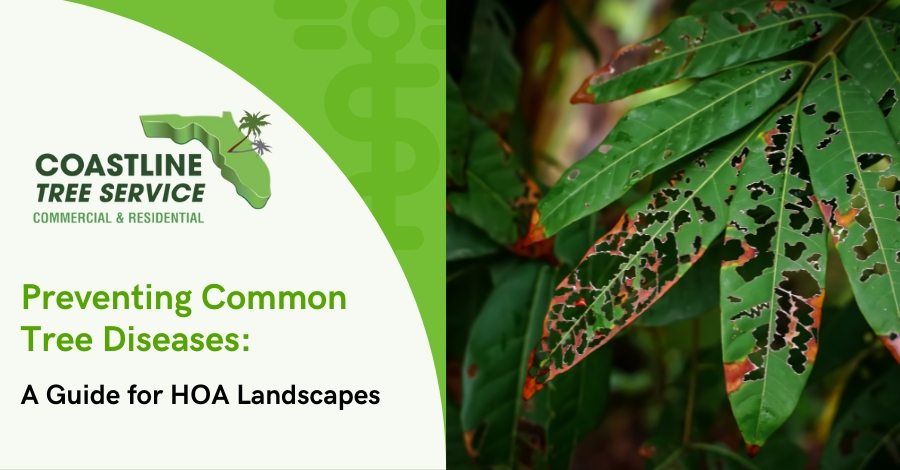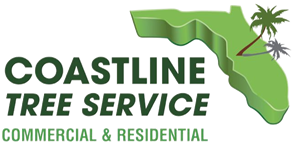
Preventing Common Tree Diseases: A Guide for HOA Landscapes
Homeowners Associations (HOAs) play a pivotal role in maintaining the health and beauty of their community’s green spaces. However, these landscapes are susceptible to a variety of tree diseases that can threaten their vitality. Proactive tree care is essential in preventing these diseases and ensuring that trees remain robust and aesthetically pleasing. Here, we delve into common tree diseases seen in SW Florida, their symptoms, and effective prevention strategies, empowering SWFL HOAs to safeguard their landscapes.
Understanding Common Tree Diseases
Tree diseases in Southwest Florida pose significant threats to the health and aesthetic of community landscapes. Here are the top 10 common tree diseases in the region:
-
Ganoderma Root Rot: This disease is caused by the Ganoderma fungus and primarily affects the roots and lower stem of trees, leading to structural instability. Symptoms include wilting leaves, thinning canopies, and the presence of conks or bracket fungi at the tree’s base. Palms are particularly susceptible to this disease, which spreads through the soil, often exacerbated by waterlogging and poor drainage conditions. Managing soil health and ensuring proper drainage are critical in preventing its spread.
-
Anthracnose: Affecting a variety of trees including sycamores and oaks, Anthracnose is characterized by leaf spots, blighted foliage, and twig dieback. The disease thrives in wet, cool spring conditions, as it is spread by fungal spores that overwinter in fallen leaves and infect new growth. Regular pruning of infected branches and proper sanitation practices, such as removing fallen leaves, help mitigate its impact.
-
Laurel Wilt: This deadly disease affects trees in the laurel family, including redbay and avocado. It is caused by a fungus transmitted by the invasive redbay ambrosia beetle. Symptoms include rapid wilting, dark streaks in the sapwood, and leaf desiccation. The disease spreads as beetles bore into healthy trees, making prompt removal of infected trees crucial to control its spread.
-
Fusarium Wilt: Primarily found in palms, Fusarium Wilt causes fronds to yellow and die, starting from the oldest leaves. It is caused by a soil-borne fungus that enters through root wounds. The disease is often spread through contaminated pruning tools and soil. Sterilizing equipment and avoiding planting susceptible species in infested soils can help prevent the disease.
-
Powdery Mildew: Commonly affecting trees like crape myrtles and maples, powdery mildew appears as a white, powdery coating on leaves and stems. It thrives in warm, dry conditions, spreading through airborne spores. The disease can weaken trees, leading to premature leaf drop. Ensuring good air circulation and applying fungicides can help manage its prevalence.
-
Sooty Mold: This disease doesn’t directly infect trees but grows on the honeydew excreted by sap-sucking insects like aphids and whiteflies. It appears as a black, sooty coating on leaves and branches, which can affect photosynthesis. Controlling the insect population is essential to managing sooty mold, often requiring integrated pest management strategies.
-
Bacterial Leaf Scorch: Affecting oaks and maples, this disease is spread by leafhoppers and other insects. Symptoms include marginal leaf browning and premature leaf drop. The bacteria clog the water-conducting vessels, leading to dehydration. Removing infected trees and controlling insect vectors are key strategies in managing its spread.
-
Phytophthora Root Rot: This soil-borne pathogen affects a wide range of trees by attacking the roots, leading to stunted growth and yellowing leaves. It thrives in poorly drained soils and spreads through water movement and contaminated tools. Improving soil drainage and applying fungicides can help control the disease.
-
Canker Diseases: Various fungi cause cankers, which are sunken, dead areas on branches and trunks. They often occur following physical damage or stress and can girdle branches, leading to dieback. Trees like pines and spruces are commonly affected. Pruning out infected areas and reducing environmental stressors can prevent their spread.
-
Leaf Spot Diseases: These diseases, caused by various fungi and bacteria, result in spots on leaves that can coalesce, causing defoliation. Trees such as dogwoods and cherries are frequently affected. Leaf spots are often spread by water and wind; hence, maintaining good sanitation and applying appropriate fungicides can minimize their impact.
By understanding these diseases and implementing proactive care measures, HOAs can maintain healthy and vibrant landscapes in Southwest Florida.
Importance of Regular Maintenance
Regular tree maintenance is a cornerstone of disease prevention. This involves routine inspections to identify early signs of disease, allowing for swift action before the condition worsens. Pruning is a vital maintenance practice that helps remove diseased or dead branches, reducing the spread of pathogens. Furthermore, ensuring trees are properly watered and fertilized enhances their resilience against diseases. Trees that are stressed due to poor nutrition or inadequate hydration are more susceptible to infections, making regular maintenance an essential preventive measure.
Strategies for Disease Prevention
Implementing effective strategies for disease prevention is crucial in maintaining healthy and thriving tree landscapes in HOA communities across Southwest Florida. Here are some recommended approaches to consider that should help prevent the onset and spread of tree diseases:
-
Cultural Practices: Establishing robust cultural practices forms the foundation of disease prevention. This involves regular sanitation measures such as removing fallen leaves, branches, and other debris that might harbor pathogens. HOAs should promote proper mulching techniques to maintain soil moisture and temperature, which discourage disease development. Educating the community about the importance of not overwatering their gardens and lawns can prevent waterlogged conditions that favor root diseases. Moreover, conducting regular pruning of dead or diseased branches helps in removing potential infection sites and improves air circulation, reducing the humidity levels that many pathogens thrive in.
-
Environmental Management: Adjusting the landscape environment to create unfavorable conditions for disease development is another effective strategy. This includes ensuring proper site drainage to prevent water accumulation, which can encourage root rot and other waterborne diseases. Implementing integrated pest management (IPM) systems can keep pest populations in check, minimizing the risk of secondary infections carried by insects. Incorporating organic compost into the soil can enhance soil health and microbial diversity, creating a natural defense barrier against pathogens. Additionally, using environmentally safe fungicides as a preventive measure can provide an extra layer of protection without harming beneficial organisms.
-
Selection of Disease-Resistant Species: Choosing tree species that are naturally resistant to local diseases is a proactive approach to disease prevention. HOAs should work with local arborists to identify and plant these species, as they are better adapted to the region’s specific climate and soil conditions. For example, selecting species that are resistant to common diseases like Fusarium Wilt or Anthracnose can significantly reduce the incidence of outbreaks. Planting a diverse range of species can also prevent large-scale damage from a single disease, promoting ecological balance and resilience in community landscapes.
-
Proper Planting Techniques: Ensuring trees are planted correctly can prevent stress-related diseases. This involves selecting the right planting site based on the tree’s light, soil, and space requirements. Trees should be planted at the correct depth, with the root flare visible above the soil line, to prevent root rot and other stress-related conditions. Providing adequate spacing between trees can improve airflow and light penetration, reducing the humidity levels that foster disease development. HOAs should also consider the long-term growth potential of trees to avoid overcrowding and competition for resources.
-
Regular Monitoring and Assessment: Establishing a routine monitoring schedule allows early detection of disease symptoms, facilitating prompt intervention. HOAs should engage professional arborists to conduct periodic health assessments of the community’s trees, identifying any signs of stress or infection. Implementing a tree inventory system can help track the health and maintenance needs of each tree, ensuring timely care and management. Encouraging residents to report any unusual symptoms they observe can enhance community involvement in disease monitoring and prevention efforts.
By integrating these detailed strategies for disease prevention, HOAs in Southwest Florida can maintain vibrant and disease-free landscapes. Proactive management not only preserves the aesthetic and economic value of community spaces but also contributes to the overall health and well-being of residents, fostering a sustainable and harmonious living environment.
Practical Tips for HOAs
To implement effective tree care practices, HOAs should establish a comprehensive maintenance plan with the help of a Certified Tree Service Company like Coastline Tree Service. This plan should include regular inspections, pruning schedules, and guidelines for watering and fertilization. Educating residents about the importance of tree health and encouraging their involvement in reporting signs of disease can foster a proactive community approach. Additionally, by securing a partnership with us, ensures access to expert advice and services, elevating the standard of care for community landscapes.
How Coastline Tree Service Can Help
Partnering with professional tree services, like us here at Coastline Tree Service, is instrumental in disease prevention and management. Our certified arborists possess the expertise to diagnose and treat tree diseases effectively, offering tailored solutions that align with your community’s unique needs. We can implement advanced techniques, such as soil aeration and root collar excavation, to improve tree health and prevent disease onset. Engaging with our professional services ensures that trees receive the care they need, providing peace of mind for HOAs and enhancing the longevity of their landscapes.
By prioritizing tree health and implementing these preventive strategies, HOAs in Southwest Florida can maintain vibrant and disease-free landscapes. Proactive care not only enhances the aesthetic appeal of communities but also contributes to the overall well-being of residents, making the community a more desirable place to live. Coastline Tree Service is dedicated to supporting your HOA with expert tree care solutions, ensuring your landscapes thrive for years to come.
We proudly serve and offer our HOA Tree Management Services in Naples, Marco Island, Bonita Springs, Estero, Fort Myers, Fort Myers Beach, North Fort Myers, Cape Coral, Sanibel & Punta Gorda.
Give us a Call at: (239) 895-3230 or contact us online at:https://www.coastlinetree.com/contact-us/.
